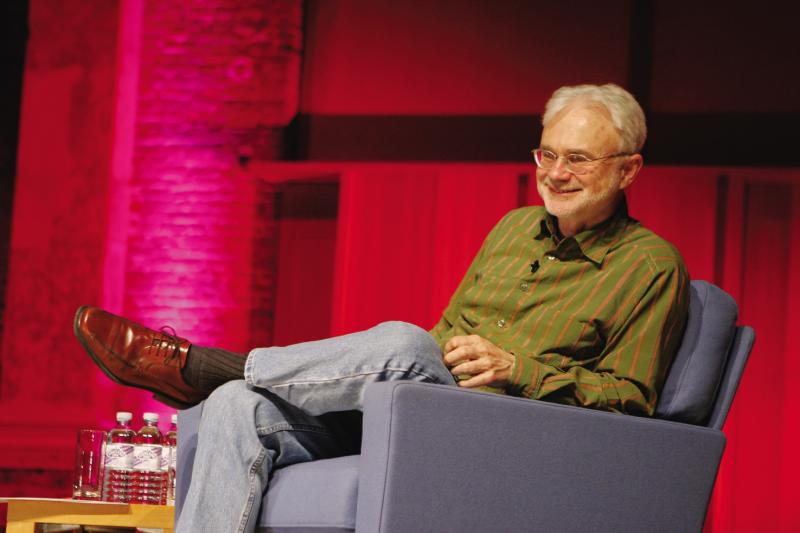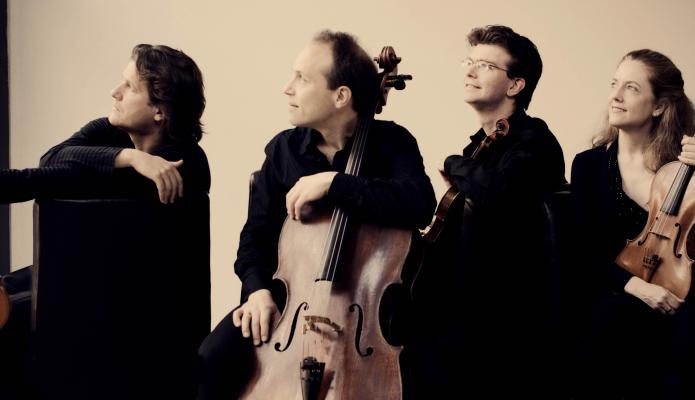St Lawrence String Quartet, LSO String Orchestra, Adams, LSO St Luke's | reviews, news & interviews
St Lawrence String Quartet, LSO String Orchestra, Adams, LSO St Luke's
St Lawrence String Quartet, LSO String Orchestra, Adams, LSO St Luke's
No sitting back and relaxing through a seminal American string symphony and a brain-dizzying quartet

“It looks like the Coconut Lounge,” remarked John Adams as he stepped up jauntily to introduce the first of two big string pieces composed 30 years apart. The folk with their drinks at the candlelit tables, though, were never allowed to sit back and let it all wash over them.
The seminal Shaker Loops of 1978, heard here in its string-orchestra incarnation of five years later, buffets and charges you as it flies or coasts through space, the polar opposite of the more placid minimalism which inspired it. That was nothing, though, compared to the strange adventure of Adams’ recent String Quartet – exhausting for the listener, as it must surely have been for the phenomenal St Lawrence String Quartet, but in a good way.
How thankful we must be that Adams' overhaul of Shaker Loops’ antecedent, Wavemaker, included a double bass among the instruments enriching the original quartet. Add two more for the orchestral version, and in the excellent acoustics of St Luke’s, the LSO trio added a resonance and a rumble that really charged up the engine, bounced into life by a knee-flexing Adams as conductor . In the second of the four seamless movements, "Hymning Slews", those basses made whalesong which complemented what Adams described as the violins’ earlier mewing “like kittens in a box”.
 Here came that much needed smooth background which gave us some respite from the vibrant shakes embodying one half of the title. Adams also had in mind for the third movement an almost extra-terrestrial imitation of what as a child he imagined to be the Shaker sect’s wild ceremonies. Will it ever stop electrifying us with the shock of the new, that series of roof-rocking, steam-train accelerating chords? Audiences in the Seventies and Eighties must have immediately realised they were in the presence of a masterpiece; we still felt it last night.
Here came that much needed smooth background which gave us some respite from the vibrant shakes embodying one half of the title. Adams also had in mind for the third movement an almost extra-terrestrial imitation of what as a child he imagined to be the Shaker sect’s wild ceremonies. Will it ever stop electrifying us with the shock of the new, that series of roof-rocking, steam-train accelerating chords? Audiences in the Seventies and Eighties must have immediately realised they were in the presence of a masterpiece; we still felt it last night.
If they’d been selling a CD and a score on the way out, I’d have bought bothWhere, though, to begin with the Quartet? Any thoughts of similarities with the early work’s shakes at the start were set aside in wonder at the cello’s dazzling pizzicato figures. The St Lawrences (pictured above by Marco Borggreve) tore into it with the total assurance and edge-of-seat commitment that can only come from knowing the work inside out. What can I add to Adams’s own observation of a team who first transfixed him with their playing in John's Book of Alleged Dances that “they can both play as an absolute unity, and also play with four individual personalities that are extraordinary and differentiated”?
That taken for granted, you could only trust them on the journey, which had all the urgency and at times anguish of Janáček's two quartets as well as the unpredictability of Beethoven’s later labyrinths. Fragments of distinctive ideas that rarely surface anywhere in many new works were hurled around the four players before you had time to grasp them, though with a crucial slowing of the pulse the scalic patterns shared in haunting dialogue did have space to make their mark. Full energy regained at the end, the St Lawrence players sent me stumbling out with brainache – again, in a good way. If they’d been selling a CD and a score on the way out, I’d have bought both and absorbed myself into the small hours. But then you’d have had to wait a lot longer for what as it stands has to be a mere superficial eulogy in praise of - yes, another masterpiece.
rating
Explore topics
Share this article
The future of Arts Journalism
You can stop theartsdesk.com closing!
We urgently need financing to survive. Our fundraising drive has thus far raised £49,000 but we need to reach £100,000 or we will be forced to close. Please contribute here: https://gofund.me/c3f6033d
And if you can forward this information to anyone who might assist, we’d be grateful.

Subscribe to theartsdesk.com
Thank you for continuing to read our work on theartsdesk.com. For unlimited access to every article in its entirety, including our archive of more than 15,000 pieces, we're asking for £5 per month or £40 per year. We feel it's a very good deal, and hope you do too.
To take a subscription now simply click here.
And if you're looking for that extra gift for a friend or family member, why not treat them to a theartsdesk.com gift subscription?
more Classical music
 Kilsby, Parkes, Sinfonia of London, Wilson, Barbican review - string things zing and sing in expert hands
British masterpieces for strings plus other-worldly tenor and horn - and a muscular rarity
Kilsby, Parkes, Sinfonia of London, Wilson, Barbican review - string things zing and sing in expert hands
British masterpieces for strings plus other-worldly tenor and horn - and a muscular rarity
 From Historical to Hip-Hop, Classically Black Music Festival, Kings Place review - a cluster of impressive stars for the future
From quasi-Mozartian elegance to the gritty humour of a kitchen inspection
From Historical to Hip-Hop, Classically Black Music Festival, Kings Place review - a cluster of impressive stars for the future
From quasi-Mozartian elegance to the gritty humour of a kitchen inspection
 Shibe, LSO, Adès, Barbican review - gaudy and glorious new music alongside serene Sibelius
Adès’s passion makes persuasive case for the music he loves, both new and old
Shibe, LSO, Adès, Barbican review - gaudy and glorious new music alongside serene Sibelius
Adès’s passion makes persuasive case for the music he loves, both new and old
 Anja Mittermüller, Richard Fu, Wigmore Hall review - a glorious hall debut
The Austrian mezzo shines - at the age of 22
Anja Mittermüller, Richard Fu, Wigmore Hall review - a glorious hall debut
The Austrian mezzo shines - at the age of 22
 First Person: clarinettist Oliver Pashley on the new horizons of The Hermes Experiment's latest album
Compositions by members of this unusual quartet feature for the first time
First Person: clarinettist Oliver Pashley on the new horizons of The Hermes Experiment's latest album
Compositions by members of this unusual quartet feature for the first time
 Gesualdo Passione, Les Arts Florissants, Amala Dior Company, Barbican review - inspired collaboration excavates the music's humanity
At times it was like watching an anarchic religious procession
Gesualdo Passione, Les Arts Florissants, Amala Dior Company, Barbican review - inspired collaboration excavates the music's humanity
At times it was like watching an anarchic religious procession
 Classical CDs: Camels, concrete and cabaret
An influential American composer's 90th birthday box, plus British piano concertos and a father-and-son duo
Classical CDs: Camels, concrete and cabaret
An influential American composer's 90th birthday box, plus British piano concertos and a father-and-son duo
 Cockerham, Manchester Camerata, Sheen, Martin Harris Centre, Manchester review - re-enacting the dawn of modernism
Two UK premieres added to three miniatures from a seminal event of January 1914
Cockerham, Manchester Camerata, Sheen, Martin Harris Centre, Manchester review - re-enacting the dawn of modernism
Two UK premieres added to three miniatures from a seminal event of January 1914
 Kempf, Brno Philharmonic, Davies, Bridgewater Hall, Manchester review - European tradition meets American jazz
Bouncing Czechs enjoy their Gershwin and Brubeck alongside Janáček and Dvořák
Kempf, Brno Philharmonic, Davies, Bridgewater Hall, Manchester review - European tradition meets American jazz
Bouncing Czechs enjoy their Gershwin and Brubeck alongside Janáček and Dvořák
 Solomon, OAE, Butt, QEH review - daft Biblical whitewashing with great choruses
Even a top soprano and mezzo can’t make this Handel paean wholly convincing
Solomon, OAE, Butt, QEH review - daft Biblical whitewashing with great choruses
Even a top soprano and mezzo can’t make this Handel paean wholly convincing
 Two-Piano Gala, Kings Place review - shining constellations
London Piano Festival curators and illustrious friends entertain and enlighten
Two-Piano Gala, Kings Place review - shining constellations
London Piano Festival curators and illustrious friends entertain and enlighten
 Echo Vocal Ensemble, Latto, Union Chapel review - eclectic choral programme garlanded with dance
Beautiful singing at the heart of an imaginative and stylistically varied concert
Echo Vocal Ensemble, Latto, Union Chapel review - eclectic choral programme garlanded with dance
Beautiful singing at the heart of an imaginative and stylistically varied concert

Add comment